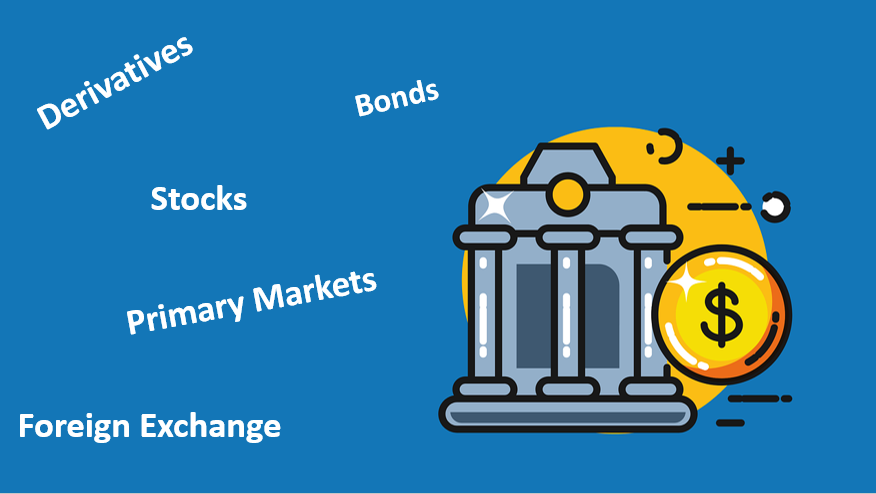Financial Markets = the arenas through which funds flow. They are an avenue through which households (savers) and business firms (savers) exchange and create financial assets such as stocks, bonds, foreign exchange and derivatives. For example, households buy investments from business firms and provide them with funds. During this process, both sectors are helped by financial markets that act as intermediaries and link these two sectors together and enable the transaction between them.
Primary vs. Secondary Markets – two major dimensions to distinguish financial markets with
Primary Markets = markets in which corporations raise funds through new issues of securities. Primary markets are known as new issue markets. It is a market where newly issued securities such as bonds and stocks are traded. In these markets, corporations sell securities to investors who provide corporations with funds through which the corporations raise capital. Corporations (users of funds) can raise capital in primary markets through various primary market financial instruments. One such method is referred to as IPO (initial public offering). IPO is the first public issue of a financial instrument by a firm, for example, when a corporation sells its shares to the public for the first time. In primary markets, investors can only buy financial assets, but they cannot sell them as this occurs in secondary markets.
Secondary Markets = markets that trade financial instruments once they are issued. Secondary markets are known as after markets where previously issued securities are bought and sold. For example, the stock exchange (a secondary market) sells stocks that are bought from IPO. Transactions that occur in the secondary market are between economic agents with excess funds and economic agents in need of funds, i.e. transactions between consumers, businesses and governments. In addition to stocks and bonds, derivative securities (financial security whose payoffs are linked to other previously issued securities or indices) are also provided in secondary markets.
The major differences between primary markets and secondary markets can be summed up as the following:
- Newly issued shares and bonds are issued in the primary market. Whereas, secondary market provides the purchase and selling of previously issued bonds and securities.
- Transactions occur between corporations (users of funds) and investors in the primary market. However, in the secondary market, transactions occur between investors and other investors, namely between economic agents and corporate security issuers are not directly involved.
- When an investor invests money in the primary market, the money goes directly into the hands of the corporation (user of funds). Whereas, when an investor invests money in the secondary market, that money goes into the hand of another investor (economic agent).
- The price of a share is determined by the corporation in a primary market. However, the price of a share in the secondary market is determined by the factors of supply and demand.
Money Markets vs. Capital Markets – two types of financial markets
Money Markets = Markets that trade debt securities or instruments with maturities of one year or less . Money markets include those types of financial instruments through which corporations can raise short-term funds, by short-term we mean a period of one year or less. To raise short-term funds, corporations borrow through financial instruments such as debt securities, commercial paper, repurchase agreements, treasury bills etc. Money Markets mainly includes inter-banking lending. In the U.S. money markets are known as over the counter (OTC) markets as transactions occur via telephone, wire transfers and computer trading rather than a specific fixed location .
Capital Markets = Markets that trade debt (bonds) and equity(stock) instruments with maturities of more than one year. Capital markets include instruments through which corporations raise long-term funds, by long-term we mean a period of more than one year. To raise long-term funds, corporations and governments (both are users of funds) borrow through financial instruments such as stocks and bonds. Capital market instruments contain a higher level of risk and a higher level of return compared to the instruments of money market.
Foreign Exchange Markets and Derivative Security Markets
The Foreign Exchange market = (OTC) over-the-counter market where trading of domestic and foreign currency takes place. There are two types of foreign exchange markets; Spot market and foreign market. The spot market is where financial instruments are traded at the current exchange rate and delivery is immediate. Whereas, the forward market is where financial instruments are traded at a future date at an agreed-upon exchange rate.
Derivative Security market = markets in which derivative securities trade.
Derivative security = financial security whose payoff is linked to another, previously issued security such as security traded in capital or foreign exchange markets. A derivative security is a financial security whose value is derived from another, previously issued financial security. For example, if the value of the previously issued security increases, the value of the derivative security should also increase.
